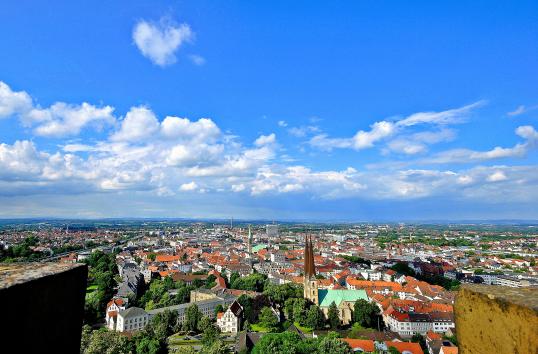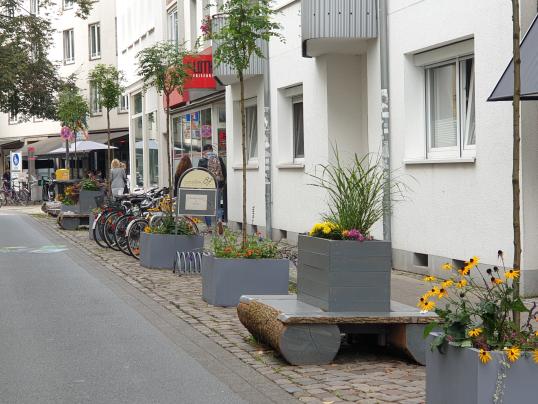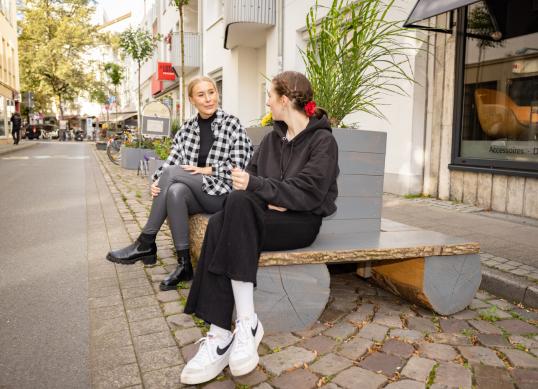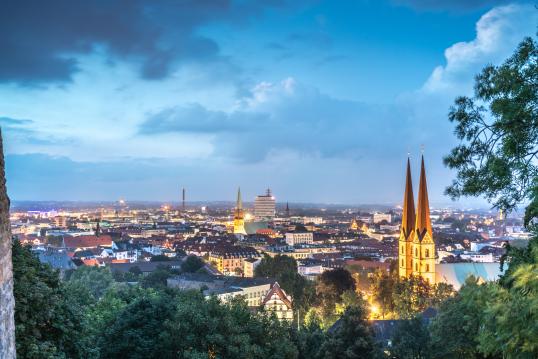- Topic
- Urban Vehicle Access Regulations
- Country
- Germany
- Resource type
- Case study
First published on 15 December 2022.
The City of Bielefeld, with its 340,000 inhabitants, is the largest and most important urban area in the East-Westphalian region. It shares a challenge with many other European cities: to keep its inner city as the central area for a multitude of functions (in line with the associated stakeholders’ interests) and at the same time react to major global challenges like climate change or public health concerns. As with many cities, Bielefeld needed to find a path to transform its inner city to meet the key interests of its different user groups, who hold many different, and sometimes contrasting, views on how the inner city should be.
In order to address these challenges, Bielefeld started its project “altstadt.raum” (‘old town space’) in January 2021. The main objectives of the project were to strengthen the functions of the Old Town as an attractive and liveable space for socialising, leisure activities, culture, trade and gastronomy. The central elements of the project were traffic calming, access regulations, the removal of on-street parking spaces, support to sustainable mobility modes and the creation of green and open spaces, which included games and seating arrangements. Since the project touched on sensitive topics, such as managing access to Old Town areas and removing parking spaces, Bielefeld decided to place the project within the frame of an intensive participation process, from which pilot measures could be proposed.
The first participation phase involved a large variety of stakeholders and served to develop a list of measures, along with potential locations where these could be tested. The first phase made use of workshops, meetings with individual stakeholders and a public survey to create the final shape of the respective pilot measures. The pilot measures started in the middle of June 2021 and were accompanied by the second participation phase, which served to discuss the first results with the main stakeholders, such as retailers and trade and commerce associations. The pilot measures were located in six different areas of the Old Town as experiments to install more outdoor seating and gastronomy, extend pedestrian zones, add greenery to the streets, remove through traffic, install cycling streets and add more bicycle parking. In addition, recreational facilities were included, such as table football and table tennis, curling and sandboxes, as well as street art.
After three months, the pilot activities were evaluated by the public, who were grouped into specific user groups, such as residents, retailers, visitors and passers-by, to learn the views and opinions of different users. The results gave a mixed picture, with the majority of residents, visitors and passers-by expressing a positive view on the pilots, and retailers expressing a negative experience. There were also contrasting views, depending on people’s individual modal choices. Not surprisingly, pedestrians and cyclists supported the effects of the pilot activities, while car drivers reported that the pilots had made the inner city less accessible for them and that the new traffic flow regulations had not been well communicated and installed.
The main working group of the participation process, including representatives of all affected stakeholders, reflected on these results and concluded that changes were necessary to some of the pilots. As a result, they developed a first proposal for each measure per location that they felt could become a permanent solution.
The pilot activities were stopped at the end of February 2022 to perform traffic counts and compare these with the data that had been collected at the same locations during the pilot activities. In autumn 2022, based on the results of the pilot activities, the city was due to take the next step and continue its intensive participation process to develop further ideas for measures and finalise the piloted measures in order to deliver permanent changes to the city’s Old Town.
Context
Inner city development is a challenge for many cities, as was the case for Bielefeld in Germany. Inner cities are meant to be lively centres for trade, gastronomy, leisure, work, living, culture, education and more. They need to be easily accessible for everyone, while at the same time addressing the need to protect the climate and public health. The interests and expectations of those who live and work in the city often conflict. However, the need to act does not become any less important in the face of these multi-layered perspectives: cities must find development strategies for their inner cities that embrace a multitude of functions and address the contrasting interests of users as well as higher-level concerns, such as mitigating climate change.
In the case of Bielefeld, this translated into starting a fundamental transition process to adapt its historical centre, the Old Town, to meet these demands. To start the transition process, the City of Bielefeld created its project “Emission-Free Inner City” (Emissionsfreie Innenstadt), which was funded by the Province of North Rhine-Westphalia. This project focused on improving the quality of life and addressing climate protection and public health in the inner city to deliver attractive, safe, and liveable public spaces. Transport and mobility took a key role since the City of Bielefeld pledged to halve the modal share of cars and other individual motorised traffic from today’s 50% share to 25% by 2030. Bielefeld’s transport lighthouse project that was part of this, the redesign of Jahnplatz, a major urban traffic node (just north-east of the Old Town), received a lot of public interest, even beyond the city limits (see ELTIS Case Study on the Jahnplatz redesign). The direct proximity of Jahnplatz to the Old Town triggered interest amongst public and private stakeholders for action to also be taken to improve the attractiveness and reduce traffic use in the adjacent Old Town. Consequently, the city launched the “altstadt.raum” (‘old town space’) project at the start of 2021.
In action
The “altstadt.raum” project was undertaken within the framework of the Horizon 2020 project ReVeAL(link is external). It worked to strengthen the functions of the Old Town, to make it an attractive and liveable space: creating more space for socialising, leisure activities, culture, trade and gastronomy. Or to turn it around, fewer GHG emissions, less noise, less traffic and consequently less space for traffic, particularly motorised traffic. Central elements of the project aligned well with those of the “Emission-Free Inner City” project: calm traffic, create a better quality of life and better safety and security conditions within the Old Town. Precise measures focused on access restrictions to sensitive parts of the Old Town, the reuse of on-street parking spaces, the optimisation of traffic flow and the promotion of sustainable transport modes.
However, it was the actions to restrict motorised access and change the use of parking spaces that provoked controversial reactions and discussions within the city. Ultimately, objectives and measures within the framework of the “altstadt.raum” project needed to meet the diverse interests of the Old Town stakeholder groups. Consequently, the city of Bielefeld, anticipating intense discussions on these topics, set up an intensive participation process, from which pilot actions were generated, that also continued alongside the implementation of the pilot measures.
The project started in January 2021 with its first participation phase aimed at defining the details and locations for the pilot activities within the Old Town, which were due to start in the summer of 2021. The first move was to meet with the association of retailers of the Old Town area, one of the stakeholder groups most sensitive to any changes, since they might affect their business interests. The meeting was used to discuss the objectives and different options of the project and introduce the city’s ideas to the retailers. Based on this, a first workshop was formed of a core working group of stakeholders, including the retailers, the Old Town secondary school Waldhof, the citizens’ initiative on healthy mobility, the city administration and local political decision makers. Together they developed the action plan for the intensive participation process and defined four core themes for the Old Town’s development, i.e. that it should be a “creative.space”, a “socialising.space”, a “shopping.space” and an “activity.space”.
The second move was to extend the working group by adding further stakeholders: in addition to the core group members, the chamber of commerce, the association of hotels and gastronomy, a real estate owners’ association, further schools, churches and residents, as well as taxi and parking garage operators joined the work group. Their first large-scale workshop took up the thread of the smaller working group and collected ideas for measures to address the four main themes and put these in order of priority. The most prominent ideas were to move on-street parking to parking garages to free up public space for other uses, to create open spaces, to take action to reduce soil sealing, to add greenery, to provide lockers for shopping goods, to install parking and loading facilities for (e-)bikes, as well as to create elements for play, such as table tennis, boules or chess. The workshop also elaborated on the first ideas regarding the potential locations for the pilot activities and discussed the readiness of its participants to work on the pilot activities themselves, which met with a high level of commitment.
The results of the large-scale workshop were presented to the public as the third step of the participation process. All the stakeholders were asked to give their comments and to add further ideas on measures to pilot, as well as where to implement these. More than 500 responses were entered into the project website www.altstadtraum.de. The most prominent input by the public centred on greening projects and installing outdoor seating alongside gastronomy services. These were placed in the northern area of the Old Town, namely the Süsterplatz and the Ritterstraße (see map of the pilot activities below).
The ideas of the working groups and the public were processed during a second workshop of the extended working group. They were integrated into a single list of measures and were allocated to pilot areas within the Old Town.
The first participation phase from January to March 2021 concluded in a second meeting with the retailers of the Old Town to discuss the results before their adoption by the City Council. The plan for the pilot phase was accepted by the City Council in May 2021 and started on 14 June 2021.
The pilot phase tested measures at six locations of the Old Town. These measures were:
1. Pilot activities in the area of Süsterplatz / Ritterstraße / Niedernstraße - The pedestrian zone of the Niedernstaße was extended to give space to outdoor gastronomy, seating and greenery. Traffic was stopped from entering the Ritterstraße. Bicycle parking and lockers were placed in the nearby Renteistaße.
2. Pilot activities in the area of Altstädter Kirchplatz / Hagenbuchstraße - The Altstädter Kirchplatz was used for games, such as table tennis, table football and sand boxes, as well as new outdoor seating, bicycle parking facilities and lockers. Through traffic was temporarily stopped from using the area.
3. Pilot activities in the Waldhof street - The street was redefined as a cycling street and through traffic was stopped. Obernstraße in the north of the area was home to a new drop-off point for pupils and a car sharing service point.
4. Pilot activities in the area of Goldstraße / Güsenstraße - Additional greenery and outdoor seating were placed in these streets. The existing cycling street in the Hagenbuchstraße was extended to the Goldstraße to connect to the inner-city ring at the Obernwall. The cycling street was accompanied by adding bicycle parking and a bike-sharing station.
5. Pilot activities in the Steinstraße - Additional greenery and outdoor seating were placed in these streets. A special experiment involving retailers and artists involved street art being created in the Steinstraße. Furthermore, a car-sharing service point was added in the nearby Gehrenberg street.
6. Pilot activities in the area of Notpfortenstraße / Ritterstraße / Klosterstraße - The Notpfortenstraße was changed to a one-way street and the newly available street space was used for bicycles. Two more adjacent streets were turned into one-way-streets to simplify the flow of traffic and create space for loading and unloading zones.
The pilot phase was installed step-by-step and was accompanied by the second participation phase of the “altstadt.raum” project. The first pilot activities started in the middle of June 2021 at areas 1) Süsterplatz, 2) Altstädter Kirchplatz and 4) Goldstraße. After two weeks, the first impressions of these pilots were discussed with the chamber of commerce, the regional trade association and the Old Town retailers. Before starting the pilot activities in the remaining locations, the city administration and the Old Town retailers did a ‘walkshop’ at the pilot locations to review their performance. By the start of July 2021, the measures had begun in all of the remaining pilot locations.
The first evaluation of the pilot activities took place as early as the end of September 2021. The City of Bielefeld aimed to learn the perceptions and level of satisfaction of the stakeholders and the public regarding the piloted activities. The evaluation was done as an online survey using the altstadt.raum website as well as with passers-by in the Old Town area. The survey was structured to learn the opinions of specific user groups and resulted in a large number of responses: About 840 residents, 330 retailers, 610 visitors and 3,360 website users took part.
The majority of residents said that the quality of living in the Old Town had increased thanks to the pilot actions. However, car users complained that the level of access to their homes had decreased as a result of the pilot actions, while pedestrians and cyclists rated access as ‘good’ or ‘very good’ and added that road safety conditions had improved. The most positive feedback was given for the pilot activities in areas 1) Süsterplatz and 2) Altstädter Kirchplatz. The highest opposition to the pilot activities was in relation to area 3) Waldhof. Since the pilot activities reduced the number of on-street parking spaces, residents called for more resident parking spaces.
The majority of retailers reported that the pilot activities had had a negative effect on the accessibility of their stores, the number of customers and their turnover. They mentioned explicitly area 3) Waldhof and the adjacent street “Welle” as being particularly affected and called for the opening up of the street to all traffic users again.
The perception of visitors to the Old Town depended on their choice of transport mode used to access the area. While pedestrians, cyclists and public transport users rated access to the area as ‘good’ or ‘very good’, car drivers mentioned a decrease in the accessibility of the Old Town. Walking and cycling were rated as safer than before, whereas it was more difficult for car drivers to find their way due to the changes in traffic flows. Similar to the group of residents, visitors also liked the activities in areas 1) Süsterplatz and 2) Altstädter Kirchplatz the most and the ones in area 3) the least.
Passers-by who were interviewed supported the idea of turning the pilot activities into permanent solutions. Again, the areas 1) Süsterplatz and 2) Altstädter Kirchplatz, as well as 4) Goldstraße were met with high acceptance rates. Passers-by saw improvements in the overall reduction of traffic, less noise and a better quality of life in the Old Town. They noted other issues such as cars searching for parking spaces and the concentration of this traffic to only a few streets, as well as a general decrease in accessibility by car.
The results of the evaluation had revealed a mixed reaction from the different target groups. The City of Bielefeld started the third phase of the participation in October 2021 by discussing the results within the extended working group to define improvements to the pilot activities. This workshop elaborated on the location and nature of the measures in order to develop proposals for the final measures that would be implemented permanently. This included a reworking of the initial changes to the traffic flow in the northern part of the Old Town. In response to the comments received, it was decided to open area 3) of the Waldhof street to traffic again, with the exception of workdays between 6 AM and 10 AM to ensure the safety of pupils accessing the schools in the street. The proposals of the main stakeholder workshop were presented in three location-specific workshops during November 2021, which resulted in:
- The installation of a permanent greening measure, more support to outdoor gastronomy, more outdoor seating, more bicycle parking options and specific access regulations for residents and delivery services, as well as an extended pedestrian zone in the Ritterstraße in area 1) Süsterplatz.
- The installation of more bicycle parking options, the creation of high-quality outdoor seating, a general increase in the extent of open space areas, an easy-to-understand traffic flow regulation, including parking search guidance, as well as clear access regulations for residents, retailers and other stakeholders in area 2) Altstädter Kirchplatz.
- Keeping the revised traffic flow conditions for cars, the redesign of the street for lower traffic speeds, the development of an easy-to-understand traffic flow scheme and the installation of access restrictions for motorised vehicles in area 3) Waldhof.
- An improvement in residential parking conditions and the installation of a parking search guidance system, improvements to the school yard of the Klosterplatz and accessibility of the school itself, traffic calming of the Güsenstraße to walking speed and the installation of access regulations for the necessary stakeholder groups only in areas 4) Goldstraße and 6) Notpfortenstraße.
- Keeping the street as a one-way-street with fewer on-street parking spaces, more bicycle parking options and a redesign of the street for lower traffic speeds and less noise in area 5) Steinstraße.
The third participation phase concluded in January 2022 with a further workshop of the extended working group dedicated to access regulations for the Old Town area. The focus was the use of retractable bollards to act as filters for traffic to the Old Town, allowing user groups, such as residents and retailers, to enter the area while keeping out visitors to the Old Town. The workshop developed proposals for the location of the bollards and defined a first list of user groups that would benefit from these, split by their need for permanent access, for regular access and for single need access.
Results
The pilot phase ended at all six locations at the end of February 2022 and all installations were removed to restore the public space to its original set up, although for a limited time only. During this time, traffic counts took place to demonstrate the difference between traffic volumes and modal choices during the pilot actions (counts had been done at this time) and in the original set up of the six locations. The two sets of traffic-count data and the results of the evaluation of the pilot activities were used as the basis to define the permanent changes to be made to the Old Town areas beginning in 2023.
The City of Bielefeld is continuing with its intensive participation approach, as it prepares the details of the permanent installations in close cooperation with the Old Town’s stakeholders, starting in the autumn of 2022. In the meantime, the city administration has created a database on public space installations such as urban furniture and greenery that are suitable as permanent solutions in contrast to the pilot phase elements that focused on demonstrating the effect for a shorter time only. The most popular measure of the pilot activities, the extension of outdoor gastronomy spaces, was not stopped at the end of the pilot phase, as these spaces had already been re-installed early in the summer of 2022.
Challenges, opportunities and transferability
A clear lesson learnt from the pilot phase is that a central area, such as the Old Town of Bielefeld, is home to a wide range of different user groups and functions, which generate different and contrasting views and needs. The experience of the pilot phase clearly demonstrates that single stakeholder groups take different points of view and form different opinions and perceptions, depending on a variety of factors. For example, the level of agreement of visitors to the Old Town with the pilot measures became more and more positive the further away respondents lived from the Old Town. Furthermore, there were contrasting views from different stakeholder groups, as the majority of residents had a positive perception of the initial measures, while the majority of retailers stated the opposite. On the other hand, those visiting had different views depending on the mode they used to access the area. All these opinions and perceptions need to be captured, assessed, discussed and compiled to develop a broadly-accepted mix of measures, as part of a carefully moderated process. In addition, a lot of work was involved from the city, such as the setting up and delivering of a pilot phase (as in the Old Town experiments of Bielefeld), as well as further work to determine any permanent changes that are needed, all as part of an intensive participation process.
Certainly, the project “altstadt.raum” was an ambitious move by the City of Bielefeld, which has had successful outcomes. In addition to establishing a list of localised measures for permanent changes, the city managed to create awareness and public discussion on the future of its Old Town area. The project showcased how changes could look and based these on the ideas of stakeholders themselves. The city achieved a difficult and important step in its ambition to radically change the modal choices of people in Bielefeld.
The Old Town “altstadt.raum” project, with its intensive participation elements and its pilot activities, is certainly a good prototype for similar processes in other cities – and other city areas. However, as with most prototypes, it would need to be adapted to the respective local conditions.
In Depth
Author: Claus Köllinger
Views and opinions expressed are those of the author(s) and do not reflect those of the European Commission.





